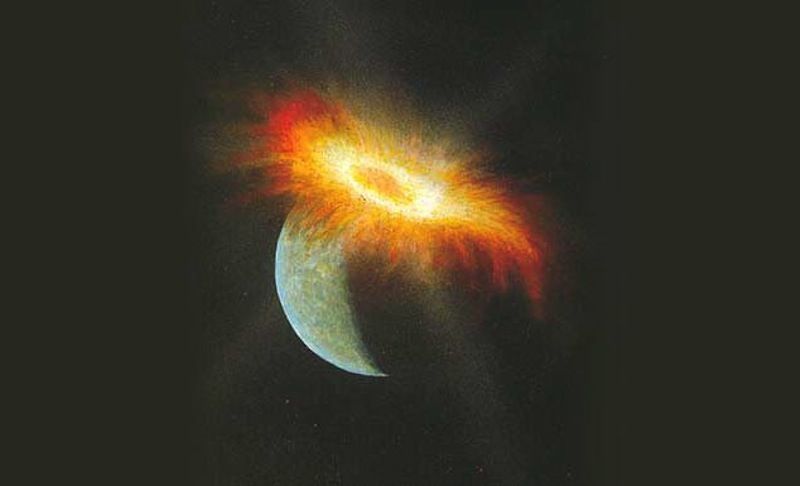Cosmic Smashups May Have Rained Metal on Early Earth

Iron vapor from cosmic impacts during the early days of Earth could have triggered "metal rain" to fall on the newborn planet, researchers say.
This new finding could help solve mysteries concerning the formation and evolution of the Earth and moon, the investigators said.
Cosmic impacts have played a critical role in the evolution of the solar system. The moon was likely born from the wreckage of a collision 4.5 billion years ago between Earth and a Mars-size object called Theia. [Photo Timeline: How the Earth Formed]
Planets generally form from a series of impacts between rocks up to the size of asteroids known as planetesimals. The speed of the collisions typically start off slow but then get faster as the planets grow bigger, with some smashups occurring at up to 100,000 miles per hour (160,000 km/h). But during the final stages of planetary formation, when the speeds, temperatures and pressures involved are high, planetary scientists do not yet have good models to describe what happens to the colliding bodies.
"One major problem is how we model iron during impact events, as it is a major component of planets and its behavior is critical to how we understand planet formation," lead study author Richard Kraus, a shock physicist at Lawrence Livermore National Laboratory in Livermore, California, said in a statement. "In particular, it is the fraction of iron that is vaporized on impact that is not well understood."
When rocky objects collide with the Earth at high speed, the impact can generate high-pressure shockwaves that compress and heat their matter. After the shockwave has passed, if this shock pressure is high enough, the compressed material will vaporize. However, it's not known how much of a planetesimal's iron core would become vaporized by an impact.
To solve this mystery, Kraus and his colleagues used the Sandia National Laboratories' Z-machine, the world's most powerful radiation source, to magnetically smash aluminum bullets into samples of pure iron at speeds of up to 50,000 mph (80,500 km/h).
Sign up for the Live Science daily newsletter now
Get the world’s most fascinating discoveries delivered straight to your inbox.
The scientists discovered the shock pressure needed to vaporize iron was only about four-sevenths of theoretical estimates. This drastically lower shock pressure means that more iron would have been vaporized in the high-speed impacts during Earth's formation than had been thought.
Prior studies assumed that iron from these cosmic impacts would have quickly sunk into the Earth's core, Kraus said.
This new finding suggests "that during the high-speed impacts that occur during planet formation, the iron will vaporize," Kraus told Live Science. "Because it vaporizes, it will expand in a plume over Earth's surface and rain out as droplets of iron. These droplets will easily mix with the mantle before they ultimately migrate to the Earth's core."
This could shed light on the formation of the Earth, the researchers said. Specifically, "this causes a shift in how we think about processes like the formation of Earth's iron core," Kraus said in a statement. "The timing of Earth's core formation can only be determined via chemical signatures in Earth's mantle, a technique that requires assumptions about how well the iron is mixed. This new information actually changes our estimates for the timing of when Earth's core was formed."
The new finding may also explain why the moon lacks iron-rich material despite getting subjected to similarly violent cosmic impacts. The researchers suggest the moon's lower gravity may have prevented it from keeping most of the vaporized iron after collisions.
The researchers are now experimenting with how materials such as olivine, forsterite and periclase — the largest components of the mantles of rocky bodies — behave in high-speed impacts, Kraus said. "With the suite of information from the iron experiments, and the experiments on the rocky mantle materials, we will have significantly more confidence in how we simulate the high-speed collisions that occurred during the formation of planets," he said.
The scientists detailed their findings online March 2 in the journal Nature Geoscience.
Follow us @livescience, Facebook & Google+. Original article on Live Science.











